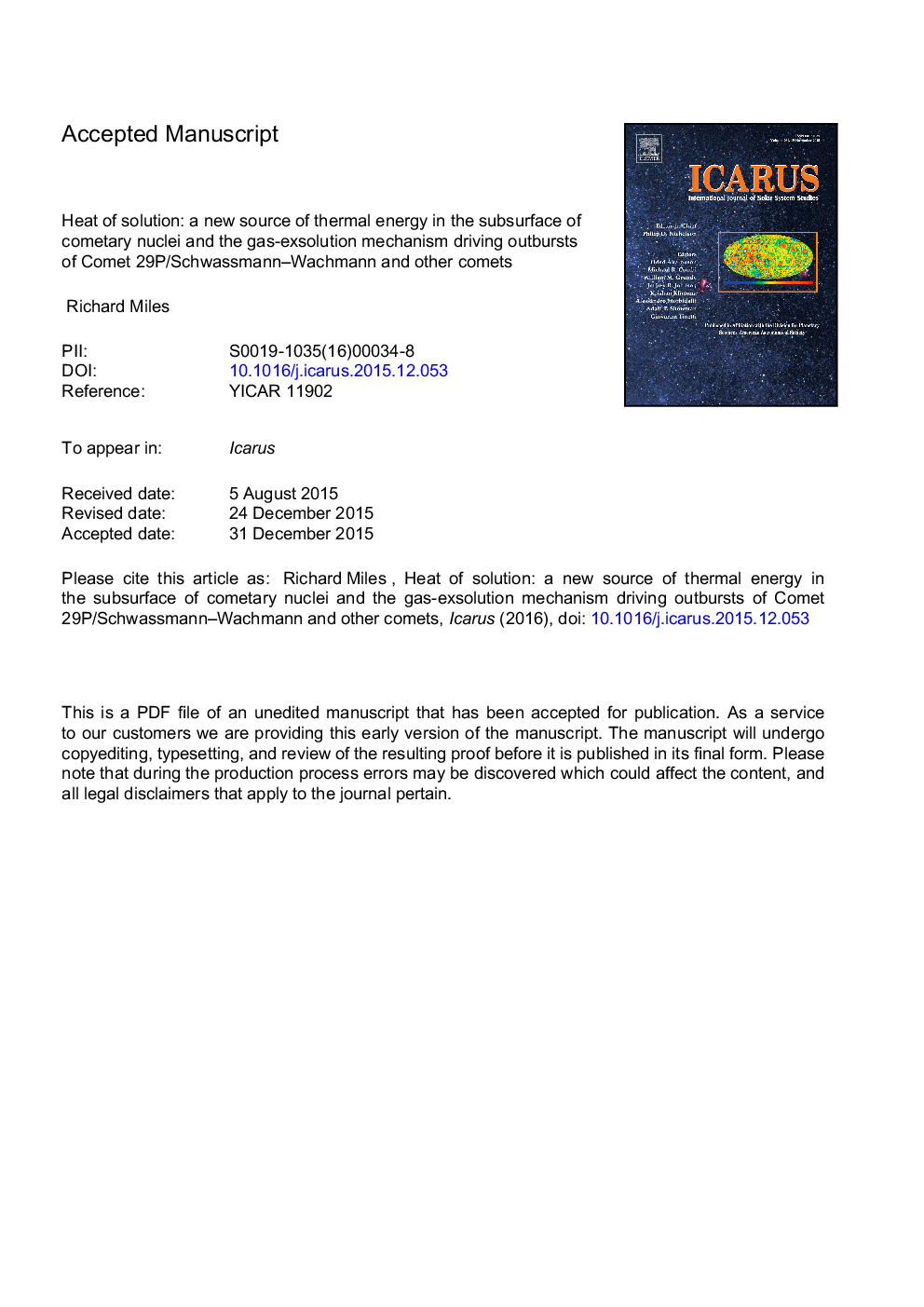| کد مقاله | کد نشریه | سال انتشار | مقاله انگلیسی | نسخه تمام متن |
|---|---|---|---|---|
| 8135336 | 1523518 | 2016 | 137 صفحه PDF | دانلود رایگان |
عنوان انگلیسی مقاله ISI
Heat of solution: A new source of thermal energy in the subsurface of cometary nuclei and the gas-exsolution mechanism driving outbursts of Comet 29P/SchwassmannâWachmann and other comets
دانلود مقاله + سفارش ترجمه
دانلود مقاله ISI انگلیسی
رایگان برای ایرانیان
موضوعات مرتبط
مهندسی و علوم پایه
علوم زمین و سیارات
علوم فضا و نجوم
پیش نمایش صفحه اول مقاله

چکیده انگلیسی
This paper is a continuation of Miles et al. (2015) [Icarus] and Miles (2015b) [Icarus], which detail new observations of Comet 29P/SchwassmannâWachmann, characterise its rotational period (â¼57 d), and identify the presence of discrete sources of outburst on its nucleus: the latter ruling out amorphous-to-crystalline H2O ice transitions as the cause of its outbursts. Summary data are presented for 29P and a further 16 non-fragmenting comets which exhibit outbursts of >2 magnitudes. A comprehensive physicochemical mechanism is postulated to account for major outbursts based on melting of cometary ices and the exothermic dissolution of gases, especially CO and CO2 at pressures of 10â200 kPa. The thermodynamics of enthalpy heating are described and heats of solution are calculated from gas-liquid solubility data yielding â6 kJ molâ1 for CO in CH4, and â15 kJ molâ1 for CO2 in CH3OH close to their freezing point. Heats of solution are â¼6 times greater (per mole) than the enthalpy of fusion of the pure CH4 and CH3OH ices, enabling gas pressures of >â¼80 kPa to continually melt these ices. Supervolatile O2 and N2 gases may also participate by dissolving exothermically in liquid CH4 and other hydrocarbons potentially reaching high mixing ratios. H2S and NH3 gases dissolve exothermically in CH3OH liberating up to 20 kJ molâ1 and 13 kJ molâ1, respectively, and all three hydrophilic species facilitate sintering of H2O ice in the near-surface of comets. Localised melting and consolidation is favoured in slowly-rotating cometary nuclei of intermediate dust/gas ratios, at pressures of â¼1 kPa, and temperatures as low as 50â65 K where O2 and N2 are abundant. Nyctogenic processes on the night-time side of the nucleus restock desiccated surface layers, reseal the crust, enabling fractionation of solutes in sub-crustal liquid phases via fractional sublimation/distillation of non-polar, hydrophobic CH4 and other hydrocarbons; and by fractional crystallisation of polar, hydrophilic phases rich in aqueous CH3OH and other organic oxygenates, e.g. CH2O, able to form low melting point eutectic mixtures. A generalised outburst mechanism is described involving the containment of gases as solutes in cryomagma beneath consolidated surface crustal regions. Disruption of the crust and associated pressure loss render the cryomagma supersaturated, and the concomitant explosive exsolution of gases provokes a cometary outburst. The CO gas-exsolution mechanism operates at â¼65 to 95 K and accounts for activity of 29P and other distant comets up to rh = â¼15 AU. A similar mechanism can operate at â¼150 to 200 K driven by CO2 in aqueous CH3OH and may account for rare outbursts of Jupiter-family comets such as 17P/Holmes. At least 10-15% of all periodic comets may be subject to gas-exsolution outbursts, the majority of which are weak and go undetected. Possible surface morphologies of the nucleus of Comet 29P are discussed. The mechanism may also explain the phenomenon of strong cometary outbursts triggering secondary events, as observed for 17P, 29P and 41P.
ناشر
Database: Elsevier - ScienceDirect (ساینس دایرکت)
Journal: Icarus - Volume 272, 1 July 2016, Pages 356-386
Journal: Icarus - Volume 272, 1 July 2016, Pages 356-386
نویسندگان
Richard Miles,